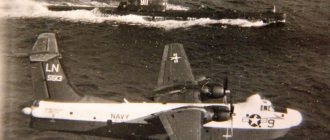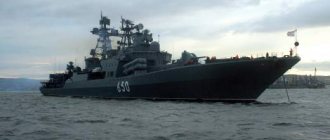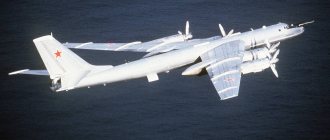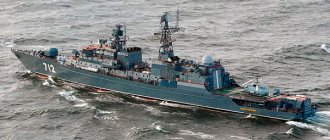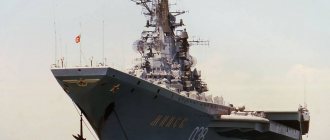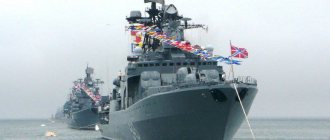Russia's vast inland waters are one of the elements of strategic military planning, which requires the creation of a strong and sustainable defense. The main instrument of the country's defense in vast inland waters were river military flotillas. The first such formations were created during the Civil War. Following the river flotillas that protected borders on large rivers, the young Soviet state created a military flotilla in the Caspian Sea. This inland sea was not much inferior in size and water-climatic conditions to the open seas, and the long coastline forced Soviet Russia to have large formations of warships in this maritime theater.
In those early years, the main force of the Caspian military flotilla were armed steamships, gunboats and boats. A little later, armored boats and river monitors began to be built for these purposes. Possessing powerful artillery, these ships were able to prove their effectiveness and combat effectiveness, becoming the first specialized artillery combat ships. In the new millennium, the glorious combat traditions of the first ships of the Caspian military flotilla are continued by small artillery ships of Project 21630. These combat ships have tactical and technical characteristics that completely change the traditional idea of such ships. The ships were built with the expectation of replenishing the Caspian military flotilla. The Caspian Sea, after the collapse of the Soviet Union, ceased to be a closed sea for Russia, so in order to secure its southern borders it was necessary to have an impressive naval force in this maritime theater.
How new generation small artillery ships appeared
The idea of building new warships for large river highways and large lakes, capable of solving a variety of operational and tactical tasks, is not new. In modern conditions, the Russian Navy is forced to think about ensuring the protection of waterways in the coastal sea zone. The Caspian Sea, being the largest enclosed sea on the planet, plays a huge role in the defense strategy of the Russian Federation. In this maritime theater, Russia borders on four states at once, each of which has its own combat vessels. The reason for such increased attention to this region is purely economic. Huge reserves of oil and gas are concentrated here, and active fishing is conducted. All this forces Russia to have large military formations in the Caspian Sea, including military ships, marines and aviation units.
Created in 1931, the Caspian military flotilla was a rather impressive force. At first it consisted of armored boats and gunboats. Later, already in the post-war period, the main combat core of the flotilla consisted of artillery boats of the Shmel and Grif type. In the 80s, the composition of the formation of warships in the Caspian Sea was replenished with Project 12411 missile boats. With the end of the Soviet period, the issue of increasing the combat capability of the Russian naval forces in this region became acute. The choice fell on military small artillery ships, river-sea class vessels, which, due to their size and dimensions, can be built at shipbuilding enterprises in Nizhny Novgorod and Tatarstan.
Small artillery ships or MAK project 21630 are universal combat vessels capable of simultaneously performing combat missions both on large rivers and in the coastal sea zone. This class of vessels was developed in the Soviet Union back in the mid-60s, making it possible to quickly organize river navigation on large waterways. The ships had fairly good seaworthiness and draft, allowing them to navigate river routes, use river canal systems and go out to the open sea. The designers of military ships decided to use this experience to build warships of a similar class, for which the main location would be the Volga River Basin and the Caspian Sea.
The new ships will have to solve the following range of tasks:
- ensuring uninterrupted river and sea navigation in these areas, control of the water space of large rivers, lakes and coastal economic zones;
- conducting patrols of the specified water areas;
- assistance to ground forces during landing operations and fire cover for troops on the flanks;
- participation in landing operations, suppression of possible pockets of resistance at sea and on land.
Similar goals and objectives were the basis for the design of the ship, which was to become a universal and modern combat vessel. Thanks to the implementation of this project, Russia had the opportunity to significantly increase its naval group in the Caspian within a short period of time. Russian warships with a displacement of up to 500 tons, equipped with powerful missile and cannon weapons, were to become masters in this naval theater.
The task of creating a new class of ships was entrusted to the Zelenodolsk Design Bureau, located in the city of Zelenodolsk, Republic of Tatarstan. The project was based on many years of experience in the design of small combat vessels, long-term hydrological observations of the Caspian Sea and the Volga river system. Military sailors presented a number of requirements to ship designers, among which the following are especially worth noting:
- new warships must have good seaworthiness and be able to withstand sea waves of up to 5-6 points;
- it is necessary to have a shallow draft, allowing ships to navigate the Volga in its lower and middle reaches without problems;
- ships must have increased autonomy and greater range;
- the weapons of ships must meet modern requirements for naval warfare.
Work on the project began in the mid-90s, when the Russian naval industry was experiencing an acute economic crisis. The fleet urgently needed new ships, so work on the project was carried out at an accelerated pace. A few years later, on the table at the Main Naval Headquarters lay a finished project for a small artillery ship of Project 21630 of the Buyan type. From a military-technical point of view, the new ship looked more like a corvette, so it is not surprising that in the Western classification the new Russian ships were immediately assigned to the corvette class, receiving the code “Buyan class corvette.”
History of the machine
According to its layout, the model belongs to the class of single-engine biplane bracing machines. The main difference from its base vehicle is the presence of an observer’s cabin in the keel section. Here is the workplace of a meteorologist who is not part of the crew.
The roots of AN 6 go back to the pre-war past. The prototype of the model was the CX-1 project, developed in 1936, but never put into production. This is due to low speed characteristics. Low-speed vehicles were not in great demand in the pre-war period.
It was only in 1945 that the idea of successfully using models with a two-level wing arose. Taking into account the use of individual aircraft, the history of aircraft designs in the USSR has never been so long for a single model.
Work on the construction of the AN 6 began in March 1948 with a test flight of a donor vehicle in standard configuration.
The first pilot of the pre-production sample is called V.A. Didenko, on March 21, 1948, he flew on an atmospheric sounder (ZA) with a new ASh-62IR engine and an AB-911-21K propeller.
But the task was not completed; the plane only rose to a height of 5 km. The engine power was not enough; the installed engine produced 850 hp. With. Taking into account the emergency landing in one of the subsequent flights in the same year, the engine control drive also required modification.
OKB-153 received the task to create a high-altitude aircraft.
Construction of the Buyan-type MAK
Despite the fact that the design of Project 21630 ships was carried out in Zelenodolsk, the construction of the first-born was entrusted to more experienced shipbuilders, the St. Petersburg Almaz Shipyard. At the very end of January 2004, the keel of the lead ship of the project, named “Astrakhan” in honor of the main base of the Caspian military flotilla, took place at this shipyard.
It should be noted that, despite its small size, the ship took quite a long time to build, more than 1.5 years. Only in October 2005, the first small artillery ship of the Buyan type was launched. During this time, serial ships were laid down; in February 2005, the first serial ship of Project 21630 “Kaspiysk” was laid down, which later received the name “Volgodonsk”. The following year, the second ship of the Makhachkala series was laid down. The subsequent construction of ships of the new project was planned to be carried out at the St. Petersburg shipyard. In total, by 2016, it was planned to deliver 10 ships of the same type to the fleet, of which five units were supposed to go to the Caspian Sea.
Initial plans to build new ships had to be abandoned. The series was reduced to 7 units. In addition, the construction of the first and second production ships was delayed. The reason for such a long delay was the problem with the choice of weapons for ships of this class. The lead ship was transferred from St. Petersburg to the Volga through a system of river canals. Since September 2006, the ship with tail number 017 was included in the Caspian military flotilla. It was he who became an experimental stand for testing new weapons, which were planned to be equipped with production models in the future. The main emphasis was placed on the perfection of the Gibka anti-aircraft missile system, which was planned to be equipped with warships. In high offices, the idea of installing more powerful missile weapons on ships, capable of solving deeper tactical and strategic problems, was considered.
The first production ships "Volgodonsk" and "Makhachkala" were launched in December-April 2011-12. During the same period, both ships with hull numbers 018 and 020 became part of the Caspian Military Flotilla, forming, together with the lead Astrakhan, the main combat core of the formation.
Design
General view of the ship
General characteristics
Total displacement - 949 tons.
Length – 74.1 m, width – 11 m, height above the waterline – 6.57 m, draft – 2.6 m.
There is partial armor (for gun turrets, wheelhouse and portholes).
Power point
Four diesel engines and two water jet propulsion. The power of each engine is 4350 hp, or 3.2 MW.
MTU 16V4000M90 engines
company MTU Friedrichshafen (Germany), however, due to the imposition of sanctions against Russia, the delivery of these engines was canceled.
Therefore, they were replaced with four-stroke diesel engines with a battery fuel system and turbocharging CHD622V20STC
from HND (PRC).
In the future, in accordance with the import substitution program, it is planned to install similar domestically produced engines on ships, manufactured by the Kolomensky Plant and the St. Petersburg Zvezda enterprise.
Crew
The total number is 52 people (officers, midshipmen and sailors). However, given the high degree of automation, it is believed that a crew of 29-36 people is sufficient to control the ship and its combat systems.
Main design features
The main feature of the design of the Buyan-class combat MACs is that all the main components, components and assemblies, and on-board equipment of the ships are of domestic production. During the production process, many parts of the hull and superstructure were unified, which made it possible to quickly launch mass production of the next modification of ships of this class, the Buyan-M type.
Based on the ships of the first series of the project, more powerful combat ships were developed. The next modification of small artillery ships was created on the basis of the modified project 21631 and received the code “Buyan-M”. These were ships with a larger displacement, 950 tons compared to the previous 500 tons. The armament of the ships also changed. The main strike component on the ships were silo-type launchers for launching Caliber cruise missiles. It was planned to install 8 launchers on the ship. The appearance of this weapon made it possible to begin the construction of an improved version of Buyan. The new ships were no longer just floating artillery platforms with limited tactical capabilities. Modern Russian corvettes have become a significant element of strategic planning. Russian ships armed with cruise missiles could launch strikes from the Caspian Sea into the depths of adjacent territories at a distance of up to 1000-1500 km.
The high combat power of the Russian Buyan-M type missile ships was confirmed by the combat launches of cruise missiles in October 2015 against the positions of Islamic terrorists in Syria. The launches were carried out from areas in the Caspian Sea, located at a distance of 1800 km from the targets.
The ships had a design that made it possible to carry out repair work in the places where the ships were permanently based, in Astrakhan and Makhachkala. As in most cases, projects 21630 and 21631 have an export version - project 21632 under the code "Tornado". Unlike domestic ships, ships built for export are designed for the installation of other types of weapons.
To date, serial construction of ships of this project has been suspended due to the insufficient power of the existing weapons. In modern conditions, a warship must have more powerful and versatile weapons capable of striking any targets, both at sea and on land. Project 21631 Buyan-M ships equipped with Caliber are much preferable. Russia has managed to become a recognized leader in this regard, having designed and built small-displacement ships armed with a missile destroyer. The future fate of small artillery ships is in question, even though there remains a need for such ships to operate on large rivers. The option of re-equipping the three ships of the project currently in service with Uran anti-ship strike systems, similar to those equipped with export-built ships, is being considered.
Links and sources of information
Project 21631 ships guarding sea borders - MRK Buyan M
- https://ria.ru/20160314/1389589685.html
- https://www.nationaldefense.ru/includes/periodics/navy/2018/0723/152524776/print.shtml
- https://army-news.ru/2011/03/korabl-buyan-21631/
- https://topwar.ru/101672-malyy-raketnyy-korabl-uglich.html
- https://baltnews.lt/vilnius_news/20190709/1019284818/Russia-korabli-izmenenie-buyan.html
- https://newsland.com/community/5234/content/malyi-raketnyi-korabl-ingushetiia-proekta-21631-otveden-na-chernoe-more/6852928
- https://flotprom.ru/2016/Oboronka184/
- Buyan Class Corvettes (Project 21630/21631)
- https://bastion-karpenko.narod.ru/21631.html
- https://flot.com/news/vpk/index.php?ELEMENT_ID=53875
- https://e-news.su/mnenie-i-analitika/309802-kakoy-flot-stroit-rossiya-i-dlya-chego.html
- https://iz.ru/959503/2019-12-28/osnashchennyi-kalibrami-korabl-ingushetiia-priniali-v-sostav-chernomorskogo-flota
- https://tass.ru/armiya-i-opk/5979716
- https://lenta.ru/news/2015/10/07/3m14/
- https://www.kommersant.ru/doc/2826759
- https://www.burevestnik.com/products/a190.html
- https://pvo.guns.ru/naval/roy.htm
- https://rbase.new-factoria.ru/missile/wobb/3m14e/3m14e.shtml
- https://rbase.new-factoria.ru/missile/wobb/3m54e1/3m54e1.shtml
- https://www.arms-expo.ru/armament/samples/1871/77237/
- https://roe.ru/catalog/voenno-morskoy-flot/korabelnye-radioelektronnye-sistemy/pozitiv-me1-2/
- https://www.oborona.ru/includes/periodics/navy/2013/0225/154010177/detail.shtml
Specifications
The main characteristics of the machine are distinguished by the following indicators:
- total length – 12.8 m;
- overall height – 4.68 m;
- wingspan of the upper tier – 18.17 m;
- wingspan of the lower tier – 14.23 m;
- total wing area – 46.8 m2;
- vehicle weight: loaded - 3.64 tons, maximum at takeoff - 5.25 tons.
The technical characteristics of the model delivered to the conveyor in Kyiv have the following values:
- The maximum flight range is 1.61 thousand km.
- Time to reach altitude: up to 7000 m in 33 minutes.
- The high altitude ceiling for stable flight is up to 10 km.
- Maximum speed indicators: at the ground - 234 km/h, at an altitude of about 7000 m - 285 km/h.
It should be noted that in operating mode the speed was maintained at 185 km/h. Landing speed is at least 80 km/h. The aircraft is operated by a crew of two people.
Given the simplicity of the design and ease of maintenance, this model served its intended purpose for many years. On the basis of this aircraft, the An-3 aircraft, an anti-balloon aircraft, and the AI-25, which already had a turbojet engine and a ceiling of 20 km, were developed.
Unfortunately, they did not go into production, but had a huge impact on the further development of aircraft manufacturing.
Warships before the twentieth century
In ancient times, the bulk of ships adapted for coastal navigation were divided by the number of rows of oars. The presence of a large number of oarsmen, who required large amounts of food, did not contribute to the development of long-distance navigation.
With the advent of the sail, the development of the fleet and the consolidation of ships began. Along with the development of navigational instruments and technologies, the fleet developed, which by the 15th century made it possible to make the first major voyages across the oceans.
The wealth of the New World spurred European shipbuilders, and already in the 16th century the design of warships began to develop and become more complex. A little later, the fleet will begin to be divided into classes and ranks. At that time, the main criterion was either the number of guns or the sailing armament of the ship.
The second classification divided ships depending on the presence or absence of certain sails. There were three-masted and two-masted sailing ships, as well as single-masted varieties of very small ships, usually used to transport mail.
The ships could have any names associated with personal names, religious or geographical components. There were cases when, for special merits, the name of a ship was left in the fleet, although the ship itself might not exist. In the Russian fleet, the most striking example was the brig Mercury and several ships Memory of Mercury.
With the advent of mechanisms and the transition from sail to machine, many names for types of ships took root and remain to this day. The main difference between any ship was its size, displacement or tonnage. The history of steamships, although not as many centuries old as the sail, has clearly written pages in the naval chronicle.
https://youtube.com/watch?v=WOUsO4CO5DQ
The development of technology has reduced entire groups of once formidable ships to nothing, and transferred classes to other ranks. So, for example, the 20th century showed the weakness of battleships in front of aircraft-carrying groups. The Second World War generally made major changes to the picture of warships in the world. And if 300 years ago a frigate was a large ship, now it has descended to the level of patrol ships.
History of creation
In mid-1966, the Ministry of Defense Industry realized the fact that the first generation of anti-tank missiles did not fit, first of all, into the lethal range standards of that time. The fire contact distance of 2.5 km was considered insufficient. But, as they say, a bird in the hand is better than a pie in the sky; the above-mentioned missiles were adopted for service.
9K111 Bassoon
A competition was announced among design bureaus, the results of which were to produce a second-generation anti-tank missile system. The military commanders wanted to get a sample manufactured according to the principle of “cheap and high quality”, and told the competitors about the technical requirements that they wanted to see in the final version of the sample.
At the same time, the military wanted the manufacturability of the process to not require large financial investments.
At the same time, the materials and technologies used by designers in the production of the defense industry clearly could not allow the production of a rocket of the given parameters. And in order to realize the wishes of the leadership, it was necessary, at least, to attract the efforts of wizards.
ATGM “Competition”
A representative of the Tula Instrument Design Bureau undertook to explain to the commanders about the expediency of the military’s demands in relation to production technologies in his presentation of the analysis of their technical specifications for the rocket. After this, the requirements decreased. Supersonic speed was replaced by subsonic speed, due to which the weight and financial investment in the manufacturing process were reduced. The development of the complex was entrusted to the Tula Instrument Making Plant.
The engineering team behind the design included musical instrument aficionados because they initially named their projected model the “Oboe.” The Bassoon system, already developed by that time, was taken as a basis.
The innovations turned out to be so successful that the plant stopped considering the project a deep modernization of the Bassoon and a year later, in 1970, the model was given a new name “Konkurs”, perceiving it as a separately designed model.
Testing of the new “tank threat” continued for another three and a half years. Designers honed the complex to an ideal state year after year. As a result, after a successful demonstration of the Konkurs ATGM to military representatives, at the beginning of 1974, an order was issued by the Minister of Defense to accept the complex for service.
Description of design
Frame
The steel hull of the AKA pr. 1204 was smooth-deck, unlike previous Soviet BKA for the use of boats in coastal shallow areas of the seas, with a tunnel formation in the underwater part in the area of the propulsors. In addition, the overall safety margin of the hull was increased (1.75) and it was divided into 12 compartments by waterproof bulkheads.
Division into compartments:
1. - forepeak (0-4 frame); 2. — midshipmen’s quarters (4-9 frames); 3. — nasal artillery bay (9-12 frame); 4. — crew quarters (frame 12-17); 5. — commander’s compartment with radio room (17-21 ½ frame); 6. — crew quarters (21 ½—25 ½ frame); 7. — control compartment for the control unit (25—29 ½ frame); 8. — generator compartment (29 ½—33 frame); 9. - engine compartment (33-41 frames); 10. - aft turret compartment (frame 41-44); 11. - galley (44-48 frame); 12. - after peak (48 frame - transom).
Booking
The following areas were reserved for AKA pr. 1204: wheelhouse
(walls 10 mm, roof 4 mm), sides (armor belt 8 mm thick from 26 to 46 sp.) and deck in the area of the engine compartment and engine control station (4 mm) , tank turret from PT-76B (front 16 mm, walls 16 mm, roof 16 mm), barbette turret, where ammunition was located (16 mm), ZPU 2M-6 (7+7 mm), barbette ZPU (16 mm) and bulkhead 26 sp (4 mm).
Power plant and driving performance
The main power plant was two-shaft with the main engines located
in one engine compartment. Diesels of the M-50F type (lifetime before overhaul 600 hours) with a power of 1200 hp were used as the main engines. every. The AC power system with a voltage of 380 V included two automated diesel generators of the “DGA-25-9” type with a power of 25 kW each, located in the generator compartment.
The AKA 1204 used the Orion remote control system for diesel units.
Cooling of the engines was provided with sea water. However, AKA 1204 on the river. The Amu Darya was equipped with an autonomous cooling system. Registers made of pipes were welded along the sides of the boats, through which water from the engines was cooled.
